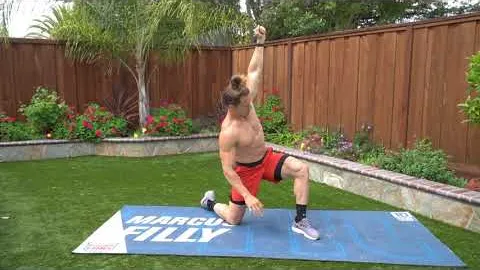
Welcome to our website, where we will be delving into the Half Kneeling Bodyweight Windmill exercise – a highly effective movement that offers numerous benefits for strength, mobility, and stability. Whether you are an experienced fitness enthusiast or a beginner looking to incorporate new exercises into your routine, the Half Kneeling Bodyweight Windmill is a great addition to any workout regimen. In this article, we will break down the exercise, discuss proper form and technique, and highlight the key benefits it provides.
The Half Kneeling Bodyweight Windmill is a dynamic exercise that targets multiple muscle groups, including the core, hips, shoulders, and thoracic spine. It involves a combination of rotational and lateral movements that mimic the act of lifting and reaching, making it a functional exercise that carries over into daily activities and sports performance.
To perform the exercise, begin by assuming a half kneeling position – one knee on the ground with the other leg bent at a 90-degree angle in front of you. The foot of the kneeling leg should be directly in line with the knee, forming a strong base of support. From this position, extend your arms overhead, keeping them in line with your ears. Engage your core muscles and slowly lean towards the side with the knee on the ground, maintaining a straight line from your hand to your foot. Pause momentarily at the bottom position, feeling the stretch in your side, and then return to the starting position. Repeat the movement on both sides to ensure balanced development.
To maximize the benefits of the Half Kneeling Bodyweight Windmill exercise and minimize the risk of injury, it is crucial to adhere to the following steps:
The Half Kneeling Bodyweight Windmill offers a wide range of benefits that make it a valuable addition to any workout routine. Let's explore some of the key advantages:
The Half Kneeling Bodyweight Windmill primarily targets the core muscles, including the obliques and deep stabilizers. The lateral and rotational movements engage these muscles in a unique way, enhancing their strength and stability. By regularly incorporating this exercise into your routine, you can improve your overall core strength, resulting in better posture, reduced risk of back pain, and increased power in other activities.
The hip joint plays a significant role in many daily movements, from basic walking to more complex athletic activities. The Half Kneeling Bodyweight Windmill exercise helps improve hip mobility and flexibility by stretching and strengthening the muscles surrounding the joint. As a result, you may experience enhanced range of motion, reduced tightness, and improved performance in exercises and activities that require hip mobility.
The overhead arm position in the Half Kneeling Bodyweight Windmill exercise contributes to improved shoulder and thoracic spine mobility. By consistently performing this dynamic movement, you can increase your shoulder range of motion and release tension in the upper back and neck. Improved shoulder and thoracic spine mobility can also lead to better posture, shoulder stability, and reduced risk of shoulder injuries.
The Half Kneeling Bodyweight Windmill exercise closely mimics the actions involved in lifting, reaching, and rotation – making it a highly functional movement. By training these movement patterns, you can enhance your ability to perform daily activities with greater ease, efficiency, and reduced risk of injury. Additionally, the transferability of the exercise can benefit athletes by improving performance in sports that require rotational and lateral movements, such as golf, tennis, basketball, and martial arts.
The Half Kneeling Bodyweight Windmill exercise requires significant core activation and stability throughout the movement. This heightened core engagement carries over to other exercises, such as squats, deadlifts, and overhead lifts, enhancing your overall performance and reducing the risk of lower back injuries. By strengthening your core through the Half Kneeling Bodyweight Windmill, you can establish a solid foundation for various exercises and movements.
The Half Kneeling Bodyweight Windmill exercise offers a vast array of benefits for strength, mobility, and stability. Its unique combination of rotational and lateral movements engages multiple muscle groups, making it an excellent addition to any workout routine. By incorporating the Half Kneeling Bodyweight Windmill exercise into your exercise regimen, you can enjoy enhanced core strength, improved hip mobility, increased shoulder and thoracic spine flexibility, improved functional movement patterns, and enhanced core stability for other exercises. So, why not try this fantastic exercise and discover the transformative impact it can have on your fitness journey!
If you're looking for a gym, fitness club or yoga studio, you've come to the right place.
You can find information about gyms in your area. Browse catalog of gyms and find gyms with classes which are you looking for.
On gym page you can find simple information like address, phone or website. You can find list of available classes. You can check availability of personal training or small group classes. On place page you can also see information about open hours.
You can find gyms near you with amenities, courts, studios and equipments.
Use our map to find gym at your city or district.
In Gym Navigator you can find list of exercises with movies for many body parts.
You can browse exercises catalog and find exercises the best of you.
You can also find exercises grouped into workout plans, which you can use to improve you body. Each routine show you exercises one by one and give you possibility to count you progress and count down rest time.